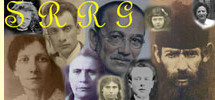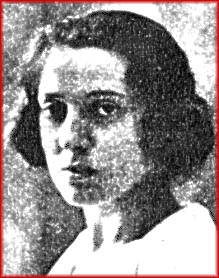

 |
Fradel Shtok was born in Skala in 1888, the daughter of Shimon and Dina Shtok. According to the AGAD records, Dina died a year after Fradel's birth, at the age of 44.[1] Fradel was raised by her father, a talented and intelligent handyman who was a controversial character in Skala. He was a loud critic of the town's Jewish communal establishment and of the imperial Austro-Hungarian regime that governed Galicia. Nicknamed Shimshon ha-gibor [Samson the mighty], after the biblical Samson, he was known as a brawler. Around the turn of the century, he was said to have been behind the beating of a local opponent by some of his cohorts. After the victim of this assault died of his injuries, Shimon Shtok was arrested, tried, and convicted in the regional capital of Tarnopol. He was sentenced to 8 years of incarceration and died in prison under suspicious circumstances.[2] After her father was imprisoned, Fradel is believed to have lived with an aunt.[3] Her life was not easy and she left Skala in the spring of 1907. She sailed on the SS Amerika from Hamburg and arrived in New York on June 17th. According to the ship's manifest, she was 24 years old, but she actually was only 19. [4] In those days, it was not unusual for a woman traveling alone to make herself older than she was, for reasons of personal safety. Information about Fradel's life in America is sparse. Her occupation was given as “dressmaker” on the ship's manifest.[5] Although it is not known whether she pursued that profession in New York, stories that she wrote about sweatshops suggest that she may have had first-hand knowledge of them. |
Her literary career began in 1910, with the publication of her romantic poem Serenade. Others of her poems and short stories appeared in a number of contemporary anthologies and literary journals, including Antologye fun Finf hundert Yor Poezye [Antholoygy of Five Hundred Years of Yiddish Poetry], edited by Moyshe Bassin (1917)[6] and Ezra Korman's Yidishe Dikhterins: Anthologye [Yiddish Women Poets: Anthology] (1928).[7] In 1919, thirty-eight of her short stories were published under the title Gezamlte Ertseylungen [Collected Stories].
This book was acclaimed by Shmuel Niger in the literary journal Di Tsukunft [The Future], but a somewhat negative review by the poet Aaron Glanz (Leyeles) appeared in Der Tog [The Day]. Glanz praised Shtok's writing style and talent, but complained that, as a whole, the collection was monotonous, and advised the author to stop writing about the shtetl and the sweatshop. Shtok was deeply angered by Glanz's review, and is reputed to have abandoned writing in Yiddish because of it.... None of the ... critics took note of the innovative thematic content in the collection.[8]Shtok's only book in English, Musicians Only, was published in 1927 and “received little critical attention.”[9]
In 1942, Fradel Shtok wrote to Abe Cahan (editor of the Forward) about the publication of a story she had written.[10] The editor of one anthology cited this letter and then said, “No further information about Fradel Shtok has come to light.”[11] According to another scholar: “By the early 1930s, Shtok had disappeared from the Yiddish literary scene. She is thought to have spent her last years in a sanatorium. The date and place of her death remain unknown.”[12]
Closer attention to her correspondence with Cahan reveals more information about Fradel Shtok. Her handwritten letter in Yiddish to Cahan, sent on the stationary of the Hotel Morrison in Los Angeles, was dated October 20, 1942, and signed “Respectfully, F. Shtok.” Underneath her signature was a note that said, “Please reply to Frances Zinn,” with a California address written in English. On November 13, 1942, Cahan answered her letter, advising her that her story would appear in the newspaper “under your literary name Fradel Shtok.” The story that is the subject of this correspondence, A Soycher fun Fel (A Fur Merchant), was published in the Forward on November 19, 1942. It may be hypothesized from this exchange of letters that Fradel had moved from New York to California, married a man named Zinn, and anglicized her name to Frances. Although no further details about her later life are known, there is a record of the death of a Frances Zinn in Hollywood on December 31, 1952.[13]
Skala's Fradel Shtok was one of the few women-writers in Yiddish of her time and was one of the first poets to write sonnets in Yiddish.[14] Although she did not have any great success as an author during her lifetime, in recent years she has been rediscovered and appreciated. Some of the works she wrote in Yiddish have been translated into English and her stories have been included in a number of anthologies devoted to Jewish writers (see bibliography). She has been called “a pioneer of modern Yiddish literature for her treatment of the inner sensual life of Jewish women.”[15] Yael Chaver, professor of Yiddish at the University of California, Berkeley said of Fradel Shtok that she “was a very fine poet who, I think, never got the appreciation that she deserved.”[16]
Chametzsky, Felstiner, Flanzbaum, Hellerstein (eds), “Selected Bibliographies: Fradl Shtok,” in Jewish American Literature: A Norton Anthology (W.W. Norton & Company, 2000), p. 1184Kellman, Ellen, “Fradel Shtok,” in Hyman, and Moore (eds.), Jewish Women in America: An Historical Encyclopaedia, Volume 2: M-Z (Routledge, 1997), p. 1249.
Mermelstein, Max, unpublished letter dated August 23, 2007.
Shtok, Fradel.
In Yiddish:
“Der Arts Vishef” [The Archbishop] and “Bai der Mil” [By the Mill] in Sefer Skala (Skala Benevolent Society, New York, 1978)--- Gezamelte ertsehlungen (Collected Stories) (New York, Farlag “Naye-Tsayt,” 1919)
--- Gezamelte Shriftn: Lider un Opshatsungen [Leaves from a Musing Heart: Poems and Occasional Pieces)] Yefin-Kats and Ruhameh-Elke (eds.)
Translated into English:
--- “The Archbishop,” in Neugroschel, Joachim (ed.), No Star Too Beautiful: A Treasury of Yiddish Stories (W.W. Norton, New York, 2002).
--- “The Shorn Head,” “Sonnet,” “A Winter Echo,” “Dusks” in Chametzky, Felstiner, Flanzbaum, Hellerstein (eds.), Jewish American Literature: A Norton Anthology (W.W. Norton & Company, 2000)
--- “The Veil,” in Forman, Raicus, Swartz, Wolfe (eds), Found Treasures: Stories by Yiddish Women Writers (Second Story Press, 1994)